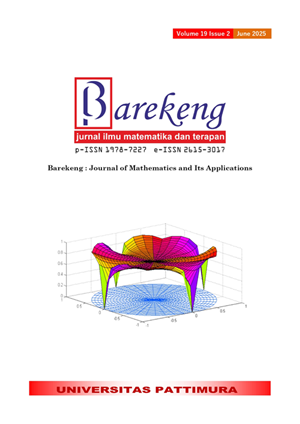CLUSTERING BASED ON BETWEENNESS CENTRALITY IN PERIOD: TRANSFORMATION OF CORRELATION COEFFICIENT VALUE INTO DISTANCE IN MATRIC SPACE
Abstract
The main information of this research is the transformation of the correlation coefficient value for stock price into the distance. It is done to create a representation in metric space that can be used in cluster analysis on the correlation network, which is a dynamic network. The dynamic network is generated from the weighted edges in the form of distances in each period. Finding the cluster members of the network can be analyzed using a simple technique called a minimum spanning tree. The central cluster member is the vertex betweenness. Vertex betweenness represents banking companies with a high degree of proximity and correlation. It means that the banks that are members of the central cluster are banks with high investment value. Clustering based on betweenness centrality in the case study of stock price correlation becomes useful when transforming the value of the correlation coefficient to distance. The effort to build a network with the edge weight being the distance makes the minimum spanning tree a simple, valuable method for cluster analysis on bank stock prices. In particular, the benefit to investors, i.e., it can reveal which assets are closely correlated, indicating that they may respond to market events in a similar way and make decisions in stock purchases
Downloads
References
E. Kalani, A. Elhami, R. B. Kazem-Zadeh, and E. Kamrani, “SELECTION OF INVESTMENT BASIS USING NEURAL NETWORKS IN STOCK EXCHANGE,” Am. J. Ind. Bus. Manag., vol. 08, no. 03, pp. 548–562, 2018, doi: 10.4236/ajibm.2018.83036.
I. Barnett and J. P. Onnela, “CHANGE POINT DETECTION IN CORRELATION NETWORKS,” Sci. Rep., vol. 6, no. June 2015, pp. 1–11, 2016, doi: 10.1038/srep18893.
T. Millington and M. Niranjan, “PARTIAL CORRELATION FINANCIAL NETWORKS,” Appl. Netw. Sci., vol. 5, no. 1, p. 11, 2020, doi: 10.1007/s41109-020-0251-z.
T. Isogai, “DYNAMIC CORRELATION NETWORK ANALYSIS OF FINANCIAL ASSET RETURNS WITH NETWORK CLUSTERING,” Appl. Netw. Sci., vol. 2, no. 8, pp. 1–30, 2017, doi: 10.1007/s41109-017-0031-6.
R. I. Tuffaha and A. Almaktoom, “USING MINIMUM SPANNING TREE TO REDUCE COST OF THE CABLE FOR THE INTERNET,” PalArch’s J. Archaeol. Egypt, vol. 18, no. 15, pp. 215–223, 2021.
P. Tewarie, E. van Dellen, A. Hillebrand, and C. J. Stam, “THE MINIMUM SPANNING TREE: AN UNBIASED METHOD FOR BRAIN NETWORK ANALYSIS,” Neuroimage, vol. 104, pp. 177–188, 2015, doi: 10.1016/j.neuroimage.2014.10.015.
X. Huang, D. Chen, T. Ren, and D. Wang, A SURVEY OF COMMUNITY DETECTION METHODS IN MULTILAYER NETWORKS, vol. 35, no. 1. Springer US, 2021. doi: 10.1007/s10618-020-00716-6.
M. Yildirimoglu and J. Kim, “IDENTI FI CATION OF COMMUNITIES IN URBAN MOBILITY NETWORKS USING MULTI-LAYER GRAPHS OF NETWORK TRAFFIC,” Transp. Res. Part C, vol. 89, no. November 2017, pp. 254–267, 2018, doi: 10.1016/j.trc.2018.02.015.
S. K. R and K. Balakrishnan, “BETWEENNESS CENTRALITY IN CARTESIAN PRODUCT OF GRAPHS BETWEENNESS CENTRALITY IN CARTESIAN PRODUCT OF GRAPHS,” AKCE Int. J. Graphs Comb., vol. 17, no. 1, pp. 571–583, 2020, doi: 10.1016/j.akcej.2019.03.012.
J. Matta, G. Ercal, and K. Sinha, “COMPARING THE SPEED AND ACCURACY OF APPROACHES TO BETWEENNESS CENTRALITY APPROXIMATION,” Comput. Soc. Networks, vol. 6, no. 1, pp. 1–30, 2019, doi: 10.1186/s40649-019-0062-5.
M. R. Yudhanegara and K. E. Lestari, “NETWORK CLUSTERING METHOD FOR PREVENTING THE SPREAD OF COVID-19 IN INDONESIAN SCHOOLS,” Commun. Math. Biol. Neurosci., vol. 2023, pp. 1–15, 2023, doi: 10.28919/cmbn/7922.
M. R. Yudhanegara, S. W. Indratno, and R. K. N. Sari, “DYNAMIC ITEMS DELIVERY NETWORK: PREDICTION AND CLUSTERING,” Heliyon, vol. 7, no. 5, p. e06934, 2021, doi: 10.1016/j.heliyon.2021.e06934.
S. W. Indratno, K. N. Sari, and M. R. Yudhanegara, “OPTIMIZATION IN ITEM DELIVERY AS RISK MANAGEMENT: MULTINOMIAL CASE USING THE NEW METHOD OF STATISTICAL INFERENCE FOR ONLINE DECISION,” Risks, vol. 10, no. 6, 2022, doi: 10.3390/risks10060122.
P. Sacks, “METRIC SPACES,” IN TECHNIQUES OF FUNCTIONAL ANALYSIS FOR DIFFERENTIAL AND INTEGRAL EQUATIONS, Academic Press, 2017, pp. 35–50. doi: 10.1016/b978-0-12-811426-1.00003-9.
M. P. A. Starmans, S. R. va. der Voort, J. M. C. Tovar, J. F. Veenland, S. Klein, and W. J. Niessen, RADIOMICS. Elsevier Inc., 2019. doi: 10.1016/B978-0-12-816176-0.00023-5.
M. R. Yudhanegara and K. E. Lestari, “PREDICTIVE DISTRIBUTION TO DETERMINE LEARNING MODEL AT THE STRATEGIC COMPETENCE LEVEL OF STUDENTS IN STATISTICS GROPUS COURSE,” BAREKENG: J. Math. App., vol. 18, no. 1, pp. 313–322, 2024, doi: https://doi.org/10.30598/barekengvol18iss1pp0313-0322.
K. E. Lestari, U. S. Pasaribu, S. W. Indratno, and H. Garminia, “GENERATING ROOTS OF CUBIC POLYNOMIALS BY CARDANO’S APPROACH ON CORRESPONDENCE ANALYSIS,” Heliyon, vol. 6, no. 6, p. e03998, 2020, doi: 10.1016/j.heliyon.2020.e03998.
K. E. Lestari, M. R. Utami, and M. R. Yudhanegara, “SIMPLE ALGORITHM TO CONSTRUCT CIRCULAR CONFIDENCE REGIONS IN CORRESPONDENCE ANALYSIS,” BAREKENG: J. Math. App., vol. 16, no. 1, pp. 65–74, 2022.
Copyright (c) 2025 Mokhammad Ridwan Yudhanegara, Edwin Setiawan Nugraha, Sisilia Sylviani, Karunia Eka Lestari, Ebenezer Bonyah

This work is licensed under a Creative Commons Attribution-ShareAlike 4.0 International License.
Authors who publish with this Journal agree to the following terms:
- Author retain copyright and grant the journal right of first publication with the work simultaneously licensed under a creative commons attribution license that allow others to share the work within an acknowledgement of the work’s authorship and initial publication of this journal.
- Authors are able to enter into separate, additional contractual arrangement for the non-exclusive distribution of the journal’s published version of the work (e.g. acknowledgement of its initial publication in this journal).
- Authors are permitted and encouraged to post their work online (e.g. in institutional repositories or on their websites) prior to and during the submission process, as it can lead to productive exchanges, as well as earlier and greater citation of published works.






1.gif)



